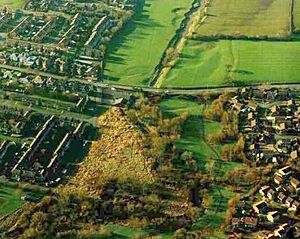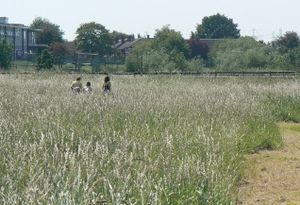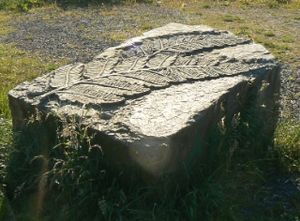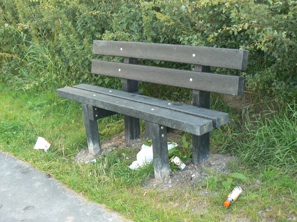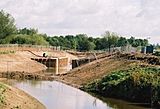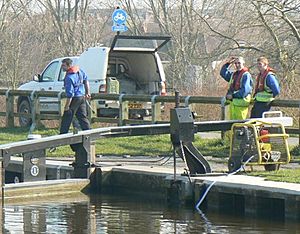Ribble Link facts for kids
Quick facts for kids The Millennium Ribble Link |
|
|---|---|

The 3-rise staircase locks
|
|
| Specifications | |
| Maximum boat length | 62 ft 0 in (18.90 m) |
| Maximum boat beam | 10 ft 6 in (3.20 m) |
| Locks | 8 (1 tidal gate) |
| Status | Navigable at certain times April–October |
| Navigation authority | Canal & River Trust |
| History | |
| Original owner | The Ribble Link Construction and Operation Limited/The Waterways Trust |
| Principal engineer | Gleeson |
| Other engineer(s) | Arup Water |
| Date completed | 2002 |
| Geography | |
| Start point | Lancaster Canal, Ingol, Preston |
| End point | River Ribble |
The Millennium Ribble Link is a special waterway and a new way for boats to travel. It connects the Lancaster Canal in Lancashire, England, to the River Ribble. This link was opened in July 2002, making it easier for boats to move between these two important waterways.
Contents
Exploring the Ribble Link's Past
How the Ribble Link Came to Be
For a long time, the marshy land around the River Ribble and Savick Brook made it hard to travel north-west of Preston. Old maps show that people used to cross the brook further inland. There was even a ford, which is a shallow place to cross a river. This old route might have been used for journeys to important places.
The Savick Brook used to be a winding, shallow stream. It was easy to cross in many spots, either by bridges or by wading. This brook was very important to local people because it had fresh water and lots of fish. It even separated two parts of a local area called Lea, one called Norman Lea and the other English Lea.
A new toll road was built across the marsh. You had to pay a fee to use it at a place called Lea Gate. Today, this is where the Ribble Link bridge goes under the A583 Blackpool Road. You don't have to pay to cross it anymore.
The Savick Brook naturally changed its path over time. It would often flood the nearby fields, creating a floodplain.
Digging into History: Archaeology Finds
When the Ribble Link was being built, experts checked the area for important historical sites. They found clues that an old mill might have been at Lock 8. They also found signs of an old farming method called "ridge and furrow" fields. Local people even called this area 'the Mill Field'.
The experts said that building the new waterway might affect these old field systems. They planned to check for old boundary ditches during construction.
Challenges: Flooding and Repairs
The Millennium Ribble Link has faced problems with flooding. In 2003 and 2004, heavy floods filled the channel with mud and damaged parts of the waterway. This made it impossible for boats to use the link. Repairs cost a lot of money, over £124,000.
The Ribble Link had to close again in 2006. Another £600,000 was spent on clearing out mud (called dredging) and fixing things.
The Savick Brook used to be affected by tides all the way up to Haslam Park. This area is now at the bottom of the three-lock staircase.
Because the brook met the sea, it was a place where flatfish would breed. Other fish that travel long distances also used the Savick Brook to lay their eggs.
When the Millennium Ribble Link was built, it included locks and straight sections. The original winding parts of the Savick Brook were left alone. Special overflow weirs were built at each lock to let water keep flowing through the old brook. Fish passes were also added to these weirs, allowing fish to swim through.
The Millennium Ribble Link was the first inland waterway built in Great Britain in almost 100 years. It opened in July 2002. What's special is that it was built only for fun and leisure, not for business. It's a navigation, which means boats can only travel in one direction on different days.
This 4-mile (6.4 km) link connects the Lancaster Canal to the River Ribble. From the Ribble, boats can reach the main canal system by using the River Douglas and the Leeds and Liverpool Canal's Rufford Branch. However, this depends on the tides and weather.
Journey from North to South
Starting from the north, the Millennium Ribble Link begins with a holding area next to the Lancaster Canal. This is also where a sculpture trail starts. Next, you'll find a staircase of three locks, followed by a turning circle at the bottom. The Savick Brook flows in from the east here. South of this area is the beautiful Victorian Haslam Park, which is great for walking or cycling.
The link then turns west, following the path of the original Savick Brook.
You'll pass under Tom Benson Way and then immediately under a railway bridge. After this, you reach Lock 4, which has a weir. Here, you can see the 'Fire' sculpture by Thompson Dagnall. Between Lock 4 and Lock 5, there's a quiet public park to the north. To the south, you'll find the 'hay meadow', which is a very important natural area. People are welcome to visit it.
Lock 5 is separated from the Savick Brook's winding path by an island. The Savick Brook joins the canal again just after Lock 5. The 'Air' sculpture by Thompson Dagnall is located near Lock 5.
After passing under Lea Road, the Ribble Link enters a flood plain with farms on both sides. This leads to Lock 6, with its weir, and then under Tudor Avenue bridge. On your left, you'll see the training ground for Preston North End Football Club. On the right is the Ashton and Lea Golf Club. Then, after a footbridge, you'll reach Lock 7 and its weir. The Ribble Link continues through farmland, under Goodier Bridge, to the holding area at Lock 8. You can moor your boat here.
After Lock 8, the waterway becomes tidal, meaning it's affected by the sea's tides. You'll see the Savick Brook Pumping Station on the left, followed by some old woodland and a reedbed. This is near Savick Bridge, which is the main A583 road. The 'Rook' sculpture by Thompson Dagnall can be seen on the north bank.
Finally, you reach the rotating sealock at Lock 9 and enter the River Ribble. From there, you can turn west onto the River Douglas and beyond. If you're coming from the south, you'd follow this description in reverse.
More Than Just a Canal
From the very beginning, the Ribble Link project was planned to be more than just a waterway. It was designed to offer:
- A community boat for local use.
- An outdoor classroom for learning.
- Places for visitors to sit and relax.
- A footbridge and wetland areas for birds.
- Public access and enjoyment of nature.
- New natural habitats for plants and animals.
The project also aimed to improve access to the canal and boost the local economy. Because of this, a 'sculpture trail' was created along the entire length of the Millennium Ribble Link.
The Millennium Ribble Link is only open for about 90 days a year, out of 365. Around 200 boats have used the Ribble Link each year since it opened.
Understanding the Costs and Funding
The Millennium Ribble Link was built to celebrate the year 2000. It cost about £6.54 million. Over £3 million of this came from the Millennium Commission, which helps fund special projects. The rest of the money, about £3.54 million, came mainly from public funds.
The project's cost grew from an early estimate of £3.7 million to over £5.6 million. It ended up costing an extra £1.1 million more than planned. A large part of the maintenance budget for the waterway was used to cover these extra costs.
In its first five years, British Waterways spent over £2.1 million on keeping the navigation open. This included over £600,000 in 2006 for winter maintenance and dredging.
Dredging, which is removing mud and silt, is needed every year to keep the Millennium Ribble Link usable for boats. This is a known problem, and it even led to the closure of Preston Docks in 1981.
Why the Ribble Link Was Built
The area around the Savick Brook and Ribble Link often floods, according to the Environment Agency. This is why the Ribble Link was closed in 2003-2004 and 2006-2007 for repairs after flooding.
Preston City Council has rules to prevent more flooding. They say that water runoff into the Savick Brook must not increase. This is because too much water could cause flooding further downstream.
The Millennium Ribble Link is also part of a 'wildlife corridor'. This means it's an important area for animals to move through.
The River Ribble and Savick Brook receive water from various sources, including the nuclear facility at Springfield nearby. Studies have shown that the Ribble estuary sometimes has high levels of certain metals and chemicals. The Environment Agency monitors this monthly.
Connecting the Canals: A Long-Held Dream
Originally, the Lancaster Canal was planned to cross the River Lune and the River Ribble using large bridges called aqueducts. It was also meant to connect to the Leeds and Liverpool Canal. The Lune aqueduct was built, but the Ribble one was not, because the canal project ran out of money.
Instead of an aqueduct, a tramway was built to cross the Ribble on a wooden bridge. This bridge lasted longer than the tramway itself. In the 1960s, it was replaced by a new concrete pedestrian bridge that looked like the old wooden one. This meant the Lancaster Canal remained separate from the rest of England's canal network.
The idea of building a link along the Savick Brook was first suggested in 1979. A group called the Ribble Link Trust was formed in 1984 to promote this idea. They held yearly boat trips, starting from the Leeds and Liverpool Canal, going down the River Douglas, up the River Ribble, and ending at Preston Dock. These trips showed that canal boats could safely travel on this tidal water.
The original plan for the link involved Sharoe Brook and Haslam Park. However, there were many problems with getting permission to use the land. The connection to the Lancaster Canal needed a set of locks in a tight space. The final design used a three-lock staircase with a turning basin at the bottom. This allowed boats to make the sharp turn. Because the Savick Brook is tidal, it was decided early on that boats would only travel in one direction at a time.
There were many delays and rising costs during the project. The project was also complicated because British Waterways, the organization in charge, had rules about what they could spend money on. A new company, The Ribble Link Construction and Operation Limited, was set up to manage the project.
The company Gleeson was chosen to build the link in November 2000, with Arup Water designing the details. Several groups worked together to manage the project, including British Waterways, Lancashire County Council, the Ribble Link Trust, and The Waterways Trust.
More Than 'Just a Canal'
The Millennium Commission agreed to help fund the Ribble Link as a community project. They wanted it to be a 'linear water park' that included:
- Beautiful landscaping.
- Artworks and historical information.
- Footpaths and cycle paths.
- New habitats for wildlife.
They wanted it to be something special for the new millennium, not just a canal.
Money was also given to buy a community boat for the Ribble Link. This boat, named 'Millennium Swiftsure', was meant for local people and for educational trips. It was even made accessible for wheelchairs. However, the boat was never used on the Ribble Link and was moved to Lancaster to be a water taxi.
Fishing used to be a popular activity on the Savick Brook. Even though it was promoted as a benefit of the new link, fishing is actually not allowed on the Millennium Ribble Link.
The Lancashire Environmental Fund also contributed money to support public access and improve natural habitats.
The Millennium Commission provided £3,300 for visitor seating made from recycled materials, installed in 2007. Lancashire County Council spent £80,000 to pave the cycle route along part of the Ribble Link, connecting it to the national cycle network.
An important piece of land, a traditional hay meadow, was identified as being very important for nature. The Millennium Commission gave £30,000 to improve this hay meadow for public enjoyment. British Waterways used this money to replace the fence around the meadow with a new one made from recycled materials.
A public footpath runs from Lea Road, next to the Ribble Link, across the hay meadow.
An outdoor classroom was originally planned as part of the project. It was later moved inside the local primary school grounds. This classroom has carved wooden benches and information about wildlife on the canal.
The hay meadow nearby is designed to be a safe place for wildflowers and insects.
Visiting the Ribble Link
When you visit the Ribble Millennium Link, you might see civilian and military aircraft flying overhead. This is because it's under the flight path of Warton Aerodrome, so it can be noisy at times.
The Banded Demoiselle, a large and colorful type of damselfly, has been found in this area. It spread to Savick Brook in 1997 and was well-established by 1999. It was also seen on the Lancaster Canal and Leeds-Liverpool Canal.
The yearly dredging of the Ribble Link might affect these insects.
The Millennium Ribble Link offers many things to see and enjoy, including different plants, animals, and butterflies.
How the Ribble Link Was Built
Construction started in February and March 2001. The plan was to build the lower part of the waterway first. However, an outbreak of Foot-and-mouth disease in May 2001 meant that all nearby farmland was closed. So, they had to start at the top instead. Work began on Lock 5, then Lock 4. Both were built on dry land between the curves of the old brook.
The builders used a special vibrating machine to drive steel poles into the ground. This helped reduce noise. These poles formed the walls of the locks. The staircase of locks was the first ever built by machine, which required new skills. Once the restrictions were lifted in July 2001, work on the lower section could begin.
In August 2001, some parts of the canal had very tight bends. After testing with a 70-foot (21 m) measuring rod, some bends had to be changed. The navigation was designed with huge weirs near all the locks to handle big floods. But even before they were built, heavy rain in late August caused major flooding. This damaged the new banks, washing them into the channel. More floods happened in September and October, meaning work had to be redone. Lock 6 was the only lock built directly on the brook's path. Water had to be moved around the site in pipes while they built it.
The lock gates were made in Northwich. The first gates were installed at Lock 5 in late October 2001. By the end of the year, gates were fitted on Lock 4 and the staircase. Work also began on a temporary dam around the tidal gate. In January, construction started on a raised walkway under the railway bridge. On January 28, a very high tide flooded the lower part of the site, but it caused little damage. A new bridge was needed for the golf club. A large steel tube was built on the bank and then lowered into the channel by a crane.
The bridge for the Lancaster Canal towpath arrived from the Netherlands on March 26. However, the delivery truck couldn't get close enough, so it wasn't installed until April 3. More flooding happened on April 29 due to heavy rain and a high tide, causing more damage.
In June 2002, the temporary dam around the rotating gate was removed. The first boat entered the waterway, a British Waterways maintenance boat, traveling from the Lancaster Canal into the connection basin. In July 2002, several boats used the navigation to help test the locks and how they worked. These boats belonged to members of the Ribble Link Trust. They traveled from Preston Docks to the Lancaster Canal. The official opening was on September 20, 2002, by Margaret Beckett, who was a government minister at the time.
The Ribble Link closed in 2006 because parts of it were unsafe. After dredging and repairs during the winter of 2006-2007, the link reopened on April 6, 2007.
How the Ribble Link Works
The Millennium Ribble Link is located north-west of Preston. It follows a straightened and deepened section of the Savick Brook. The channel was made wider for boats up to 10.5 feet (3.2 m) wide. One side of the brook has natural reed edges to protect wildlife. Artificial sand cliffs were also built for nesting birds like sand martins.
Besides being used by boats, a main goal of the project was for walkers, cyclists, and nature lovers to enjoy it. To make it more interesting, an art sculpture trail was created along the waterway. One sculpture, called "Gauging the Ripple" by Thompson Dagnall, was near the Lancaster Canal. However, it was later removed due to structural problems.
The link is open only during certain times of the year, usually from April to mid-October. Even then, it's only open on about 90 days, depending on the weather. You need to book your passage in advance with British Waterways. Boats travel in alternate directions on different days. The sea lock at the Ribble end and the triple staircase at the Lancaster Canal end are operated by British Waterways staff. The other locks are operated by the boat crews themselves.
There is no charge to use the Millennium Ribble Link if you have a full boat license. However, boats for hire are charged £60 for each trip. A guide for skippers (boat captains) is available from British Waterways. Crossing the River Ribble can be challenging, and a pilot is available at Tarleton to help. The Savick Brook canal to the River Ribble is mostly used by experienced boat owners on longer journeys.
Starting from the Lancaster Canal, the Ribble Link goes down about 59 feet (18 m) through:
- A staircase of three locks.
- Four regular locks.
- One lock that is partly tidal at its lower end.
- A rotating gate (originally planned as a lock) that can only be passed around high tide.


